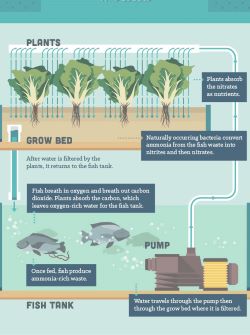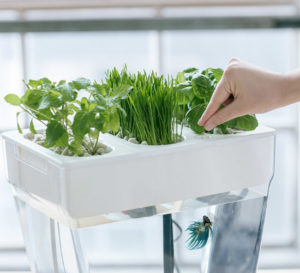Aquaponics offers gardeners the opportunity to grow their own food year-round. But why?
The growing public awareness of the importance of nutritional, healthy, and clean food follows expanding reports of the need to be more informed and involved than in the past.
On the topic of nutrition, overly processed food may deliver the flavor. But they may offer reduced food value. To be informed of the source of one’s food provides the best opportunity to consume nutritional food.
THE SIMPLICITY OF AQUAPONICS
Simplicity produces the most nutritious food when it is natural, unprocessed, and pure. Packaged convenience seems to be the reason for the more processed food that has become typical for many families. Convenience does not translate to nutrition. Furthermore, packaging has become an environmental problem.
The good news is that a bad system is often the impetus for innovation. Enter improved food growth, delivery, and identification. Progress in the area of nutrition is unfolding in many desirable ways.
Home aquaponics is a pleasingly simple, economical, and convenient method for individuals to produce and consume food. Moreover, the produce is local, unprocessed, and as unpolluted as the grower demands. It draws from the popularity of permaculture, which is as much a lifestyle as a farming technique. People are exploring exciting alternative sources of sustenance. The ability to own one’s dominion over one’s food source is the tradition of families and local communities.
Home aquaponics is a decidedly symbiotic method of food production that has the benefit of mutual cooperation within a food growing system that is economical, easy, effective, and under the control of the gardener.
One may imagine replicating a natural environment into a manageable size that fits into your environs. The manner in which you wish to farm depends on many factors. The first factor may be the climate in your region. In a warm region, you can set up your systems in the outdoors. However, you can fit home aquaponics within your home or heated enclosure in the most frigid regions.

COMMON FISH TO POPULATE YOUR TANK
A description of the synergetic nature of this food production method makes clear the benefits. A tank is used within which one raises fish, and may choose species for consumption. However, many people use the fish only for nutrient production.
The fish that may be considered include but are not limited to tilapia, rainbow trout, goldfish, channel catfish, and jade perch. Each of these fish may have different requirements as to water temperature, feeding, and compatibility. Preliminary thought as to your choice of fish is recommended.
SENSIBLE COST CONSIDERATIONS
The money-saving benefits of this system should not include the preliminary set-up, which can make the difference between success and failure. For instance, the use of inexpensive pet-store goldfish for this particular use may introduce disease into your system. This is a first-defense in the quality control of food source. And perhaps it’s a primary reason for local or personal food growth. Generally, the set-up cost is insignificant, anyway. This self-contained will naturally produce most of the essentials needed once you set up.
The home hobby fish-tank enthusiast is aware of the nutrient-rich water produced. The same nutrients in a home aquaponics system are the source of natural fertilizer to grow plants. Virtually any plant, herb or vegetable can be used in this system. But there are several types of vegetables that have most successfully been grown by local and home farmers.
VEGETABLE CHOICES
The most popular vegetables for the beginner farmer include leafy lettuce, cucumbers, tomatoes, cabbage, strawberries, and watercress. After one has become proficient in this craft, one will sufficiently understand the process and peculiarities of different plants, herbs, and vegetables to expand to the extent of one’s experience. In the beginning, perhaps sticking with the tried and true is the best decision.
EQUIPMENT
Preliminary equipment will include the fish tank set up which is similar to that of the average hobby system and is dependent on the size of wish you choose. Circulation can be accomplished by use of the connection between the fish tank and vegetable bed. However, one needn’t use a vegetable bed. Some vegetables will grow directly into the fish-tank water, which may limit the variety while permitting the greatest simplicity to the grower.
Types of bed differ. For example, one may choose non-soil beds with a grow-medium system. This can provide room for the growth of bacteria that is beneficial and also drainage that provides the best opportunity for success.
Many growers choose a pipe filtration system from the tank. Ito this, they set cups for the growth of plants and vegetables. This may limit the choices of plants to grow.
Another method is to float plants on water, either directly in the tank or in a different tank, with the pipe filtration continuously cycled between.
One can conclude that each of these methods mimics the natural plant growth that surrounds humanity in the natural environment. Taken a step further, this is a reintroduction of the cooperative elegance of the natural world.
QUALITY CONTROL AND AQUAPONICS
Natural control of pests that have created a problem with methods often used to control them,. The quality control measures typical in aquaponics answer this challenge. Natural production of fertilizer also will produce food that is nutritious to people, in keeping with the plant food. To expand on this fact, consider soil, which is different from dirt. One grows the most nutritious food in nutrient-rich soil, which soil is a substance different and superior to the dirt one sweeps out of one’s home. To be aware of this difference is the key to promoting better health through nutrition.
The concern for water is not inconsiderable. A smaller amount of water is necessary to grow the same amount of crops as in traditional farming. And again, the grower will control the water quality.
Traditional interest in food excellence is a reason aquaponics has become popular. You will find food items to grow with this system. Individuals or families who wish to produce their own food, with the ability to control the quality, and to do so economically is a reason for the popularity of this system.

OTHER APPLICATIONS OF AQUAPONICS
Expansion of these methods is effectively used in other ways than for the personal use of the grower. Many municipalities are exploring ways of promoting self-reliance for their citizens. If decentralization has been a reason for loss of quality control of food production and sources, these local communities can aid families by considering a community garden type of aquaponics. This can help to share costs of set up, expand your gardening talents, and share labor.
Another use of aquaponics includes the use of this system by local organic farmers. These growers are quite popular at farmer’s markets due to the excellence of their product. Expansion into aquaponics can offer another branch to these small businesses. In frigid regions, this can expand the growing season considerably. Local community members recognize the reputation of the integrity of food produced within one’s neighborhood. And they value the relationships and support these farms.
The local farmer can also use aquaponics to supply local grocery stores with fresh, organic produce year-round. This is commercially beneficial to both the farmer and the retailer, not to mention the fortunate local community members.
A small investment in research and equipment can support a wonderful natural-environment system of food production. In addition, it has the symbiotic qualities intended by nature. Quality of nutrition is the reward.

